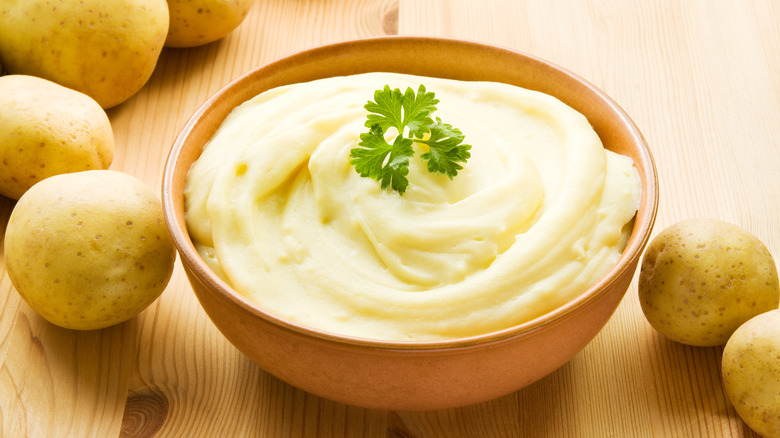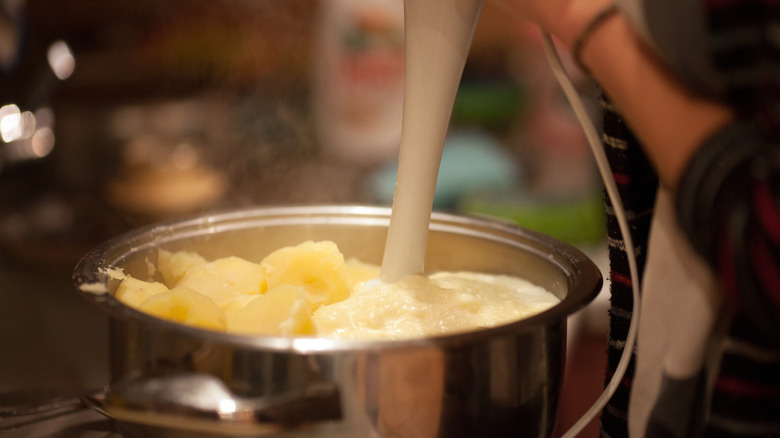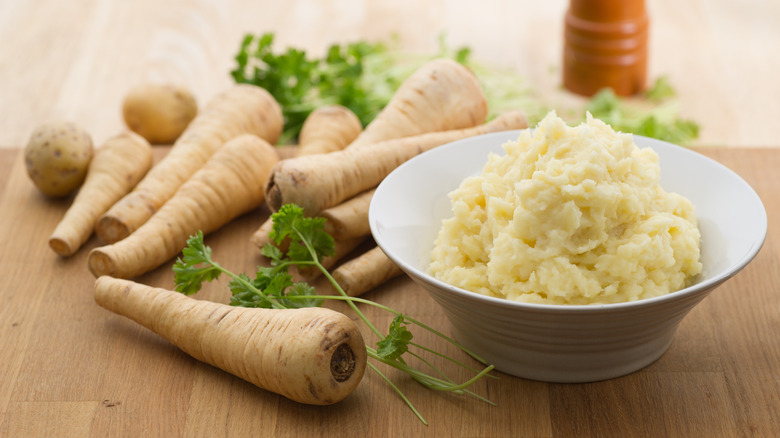How An Immersion Blender Can Mess Up Your Mashed Potatoes
A handheld immersion blender can make fast work of so many recipes, from whipped cream to silky-smooth soups. You'd think that this tool would be perfect for effortlessly mashing potatoes, a laborious task when performed by hand (and you might still end up with lumps), but think again. An immersion blender can ruin the texture of your spuds before you know it.
Excess starch is the culprit that makes an immersion blender risky to mash with. The specific starch levels in different kinds of potatoes impact their texture when cooked. When choosing the right potatoes for a thick or fluffy mash, high-starch russets produce a fluffier result, and lower-starch Yukon Golds are ideal for a creamier texture. However, even low-starch spuds can wind up gluey, thick, and dense if they're whipped or blended too hard.
The more that cooked potatoes are broken down, the more starches they release. Overwork the spuds, and the starch levels in your mash will go from just right — creating a creamy or fluffy texture — to sticky and gluey. A powerful, speedy immersion blender does a super efficient job of puréeing potatoes, but it's all too easy to get overzealous with blitzing your spuds. This causes that dreaded gummy texture in no time.
Blending potatoes creates an unfixable gluey mess
Even though a hand blender offers more control than a stand blender, it's still too powerful to mash potatoes without excessively breaking down their starches and turning them gloopy. And while some problems with mashed potatoes can be fixed — a lumpy consistency can be made smoother by mashing with more dairy, and watery potatoes can be thickened with instant potato flakes — there's really no way to save a gluey mash. Using a food processor is also a common mistake to avoid when making mashed potatoes, as it works similarly to a blender. You're better off using a potato ricer, a handheld masher, or other, gentler tools.
What if it's too late, and you have a batch of gummy potatoes on your hands? There is a way to make gluey potatoes into a delicious dish, if not one that's close to traditional mashed potatoes. Try turning the sticky batch into pommes aligot, a super-cheesy French dish that is one of the most iconic styles of mashed potatoes. This comfort food classic actually takes advantage of a gooey mash by pounding it with cheese, turning it into a stretchy potato-based fondue of sorts.
You could also mix your potatoes with shredded cheese, put it all in a dish and top with panko breadcrumbs, and bake it. This will create a warming casserole that's delightfully crunchy yet soft, and hides the stiff texture of the mash pretty well.
You can use an immersion blender to mash other vegetables
While a blender is the worst kitchen tool for mashing potatoes, you can actually use the appliance to make a nice mash if you combine potatoes with other vegetables. Diluting the potatoes with other produce decreases the starch content of the dish, and interrupts the process that makes the spuds gluey. Plus, you can make some creative and flavorsome side dishes that are more exciting than regular mashed potatoes.
Try adding other root vegetables to give the mashed mixture a richer, sweeter, earthier flavor. A parsnip and potato mash makes a great side dish for steak or other grilled meats, thanks to the hint of robust, anise-like flavor. Try adding butter for extra richness, plus some thyme, garlic, chives, and/or parsley, to ramp up the flavor further. Or, blend boiled turnips and potatoes together for a refreshing side dish that can benefit from some heavy cream or tangy sour cream.
You can also blend potatoes with cauliflower florets that have been boiled in salted water. This creates a more neutrally-flavored dish that tastes delicious mixed with butter and topped with umami-heavy Parmesan cheese. You can stick the mash in the oven to melt the cheese before serving it with meat, fish, or vegetable entrées.



